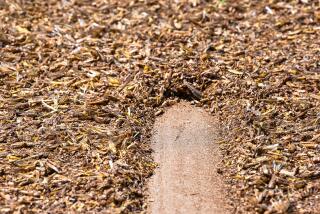Bee-Killing Mites Are Threatening Crops : Food: The parasites disrupt pollination of fruits and vegetables.
- Share via
CHAMPAIGN, Ill. — First there were the killer bees. Now there are the bee killers.
Parasitic mites are attacking the U.S. honeybee population, killing wild bees, threatening fruit and vegetable pollination and forcing beekeepers to launch expensive counterattacks.
The mites, first detected in the 1980s, have been found in bee colonies in 36 states, the U.S. Department of Agriculture said.
The mites, which are spreading rapidly, have the potential to destroy most of the wild honeybee population, said Tom Rinderer, a USDA bee researcher in Baton Rouge, La.
“Honeybees are essential to American agriculture--nothing else can replace them,” Rinderer said. As wild bees succumb, he said, “we may be looking to professional beekeepers to provide even more pollination services.”
Two hundred commercial crops worth $20 billion a year depend on bees for pollination, and the added cost of renting honeybees and compensating beekeepers for chemical mite protection could make food more expensive, Rinderer said.
Researchers hope to breed honeybees with resistance to two deadly varieties of mites now found in most states, but genetic protection could be years away.
“There is going to be a devastating loss of (wild) colonies before you see any resistance to these mites,” said Tim Dadant of Hamilton, whose company manufactures beekeeping supplies and publishes the American Bee Journal magazine. “You’re going to see a decrease in pollination in some areas.”
The mites aren’t all that beekeepers have to worry about. They have been trying to figure out how to cope with the steady northward invasion of Africanized bees, whose aggressive behavior gave them the nickname “killer bees.” The Africanized bees, which mate with domestic honeybees, recently crossed from Mexico into Texas.
Rinderer said no one knows whether the mites will attack the Africanized bees. “There’s no way to tell, and there’s no ethical way to do that experiment,” he said.
He said it wouldn’t be ethical to import the killer bees and mites into an area to see what happens.
Wild honeybees pollinate plants in parks and home gardens, as well as some field crops, and are most vulnerable to the two types of mites: the varroa, a relatively large mite that feeds on young and adult honeybees, and the trachael, a microscopic pest that lives in bees’ breathing tubes.
If local bee colonies are wiped out, there could be fewer flowers, fruits and vegetables.
Commercial food crops, from California almonds to Illinois pumpkins, are pollinated by the same kind of honeybees. In many cases, the bees are delivered to fields--often for a fee--by professional beekeepers. Most of them use chemicals to protect their colonies from mites.
The government estimates that there are 3.5 million honeybee colonies owned by more than 200,000 beekeepers in the United States. About 3,000 are professionals who make a living with bees.
Rinderer said the USDA has been testing a variety of honeybee that may be resistant to the varroa mite, and hopes to release it this fall. A honeybee resistant to the trachael mite is being tested and may be released in a few years.






